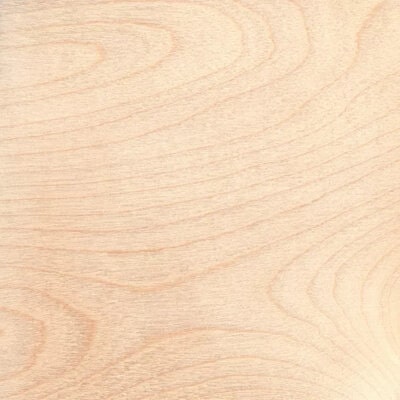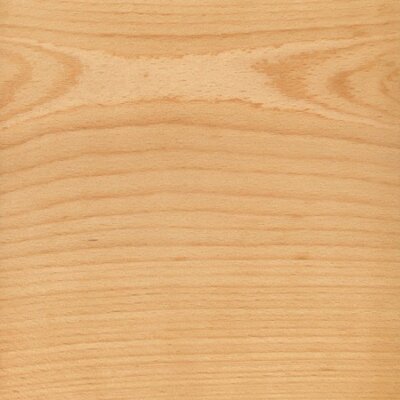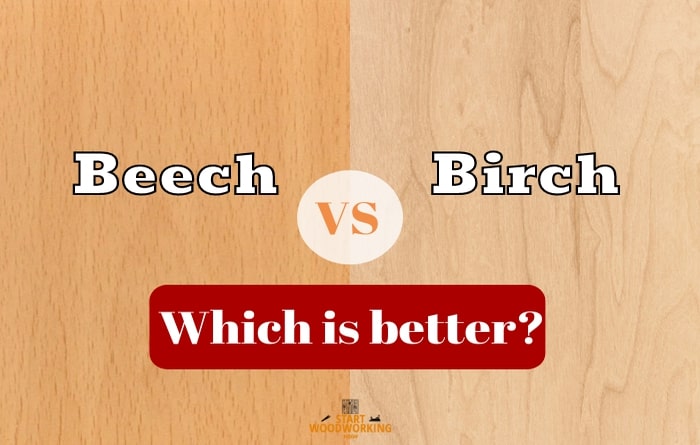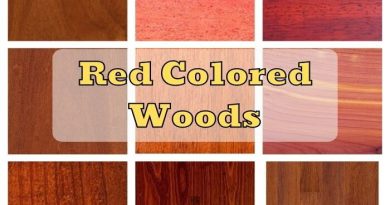Birch vs Beech (Which is the Best? | Pros & Cons)
In our seconds series of wood comparisons we have Birch vs Beech. Birch and beech sound similar, both are widespread in Europe and very widely used in the woodworking industry.
However, the two woods are different from each other and have many individual and used characteristics. Both are used commercially and in the home.
Birch
Birch is native mainly to Europe, where it has a total of about 50 different species. It is found mostly in Scandinavian countries, but also in Russia (where birch is considered the national tree), in Asia and in North America.
Two types of birch wood are used as timber: silver birch and the bog birch. Bush birch and dwarf birch are too small to be used as wood.
Birch wood is a fairly light wood. Widely used in Northern Europe for the manufacture of plywood and also in quality furniture or joinery.
The trees are medium-sized and grow between 20 and 30 meters tall. They live to be between 100 and 120 years old. Since this wood is extremely elastic and soft, it is often used in the manufacture of furniture.
Its scientific name is betula pendula . It is known as common birch or European birch.
Beech
The beech is a very common and popular deciduous tree in Central, Western and Southern Europe. It grows slowly and can get very old. Their maximum age is between 250 and 300 years.
The tree can reach 30 to 40 meters for a maximum diameter of 1.30 m. Light in color, ranging from gray-white to light rosé, this essence provides a homogeneous wood. Its heart is sometimes red, its grain is straight and its grain very fine.
Rather intended for interior uses, it lends itself well to high temperature treatment for exterior applications.
Beech wood is a leafy, heavy species, characterized by its light color (between white-orange and light pink) and by its ease of work and perfect finishes.
Even if beech is a widespread wood, it is considered a highly valuable. When cut, beech wood is white with light shades from yellow to red.
Want to know everything about beech wood, then head over this in depth article I wrote!
What is the difference between beech and birch?
The birch wood is easy to process and is relatively flexible. Beech wood is considered stable and durable. You can recognize birch wood by its low weight and its light, slightly yellowish color. Beech wood can be recognize by it’s naturally whitish color varying from yellowish-white to reddish brown. Birch is often used without waterproofing while beech wood always needs waterproofing.
Similar to the birch, the beech is also susceptible to pests, but this is counteracted by the fact that it is easy to waterproof. Impregnated wood can hardly be harmed by fungi and other pests.
Birch wood is not used as construction timber because of its low load-bearing capacity while beech it is particularly popular as solid wood in furniture construction. Birch furniture is therefore mainly found inside the house and not outdoor.
Another difference between beech and birch is that birch wood is difficult to split and when dried tends to crack while beech is easy to cut.
The birch wood is naturally elastic and flexible, but does not like humidity and is particularly prone to the formation of mold and mildew.
Beech wood is that is classified as durable against the action of fungi, insects, termites while birch wood it is susceptible to attack by fungi and insects.
You can protect your wood from fungi and mold using easy methods presented in this article!
The strength of the birch wood is close to that of a beech wood. Furniture made of birch and beech are very similar in properties, but birch products are much cheaper in terms of cost.
The steamed wood bends well, while retaining the ability to withstand shock loads. It is used by artisans to make curved legs, backs and other products.
Birch vs Beech: Comparison Table
| Properties | Birch | Beech |
|---|---|---|
| Appearance | It is a yellowish-white but also reddish-white color and over time the heartwood can turn brown or dark brown. | It is a light wood, even whitish. There is hardly any difference in color between its sapwood and heartwood. |
| Durability | It is susceptible to attack by common furniture beetles and is more or less resistant to treatment with preservatives, although sapwood is permeable. | It is sensitive to the moisture and also to some insects such as fungi, larvae and termites. |
| Workability | Good. With particular regard to turning. No difficulty when sanded or stained. Planing, milling or turning : without any difficulty. | Good. Easy wood to work with. Good workability for turning and bending. |
| Density | Birch has an average density of 650 kg /m³ so it is a semi-heavy wood. | Beech as a tree belongs to the species with an average density of wood, it is about 720 kg/m³. |
| Drying | Drying without difficulty ,easy, although with some risk of deformation. | Difficult and slow. There is a risk of cracks and / or warping. In the event of sudden changes in temperature and degree of humidity, it cracks. |
| Suitability for finishing | Good. Can be easily painted and stained. | Good. Beech wood can be easily sanded, painted and polished. |
| Suitability for assembly | Good with glue, decent with screws and nails. | Excellent with glue, it offers a good seal even with screws and nails. |
Birch vs Beech: Appearance
Birch Color

Since birch is a sapwood, in most cases it does not develop a color core. The wood of the birch is therefore very light with a yellowish-white to reddish note. Some birch woods are almost completely white and have a sheen.
The grain of birch wood is very simple and light and shows only a few patterns. However, the appearance of isolated red-brown spots on the birch wood is characteristic. In addition, the silver birch produces another valuable grain.
The birch wood then has flame-like patterns that are reminiscent of an ice flower. This particular type of birch is also known as the ice birch or black birch and comes from Finland. The patterns on the birch wood are genetically determined and are passed on to future generations.
Beech Color

It is a light wood, even whitish, and very homogeneous. Beech is a tree of the Fagaceae family, with smooth bark and white wood. Its essence is therefore quite clear but offers different shades depending on what you are looking for. Darker than birch, it combines beige and brown tones, and can even be quite dark for some species.
Aesthetically, beech wood looks like a light wood, which varies from copper blonde to reddish brown. Its grains are significant, and highlighted in different ways according to the shades of color.
Beech is a non-core tree species, that is, it does not have a visible core, therefore, it is characterized by an almost uniform color of wood fibers throughout all internal parts.
Beech wood from older trees has a slightly darker color tending to brownish-red, which can be intensified by steaming and because of this reason cabinetmakers value this in the production of furniture.
Birch vs Beech: Durability
Birch Durability
Birch has a homogeneous wood. It does not contain natural resins. Birch has high physical and mechanical properties. Its wood is highly durable, especially under shock loads.
Birch wood is heavy, hard and strong. It has very good flexibility properties as well as good pressure and impact resistance.
In general, birch wood is a very homogeneous, dense wood with excellent properties. It is hard and tough and elastic and, compared to many other woods, very flexible, but difficult to split. It is easy to machine, turning and cutting is also possible.
Birch must dry quickly as it is susceptible to degradation by fungal attack. In its machining it has a tendency to form wood pulp. It is mainly used for veneer, carpentry, furniture, sporting goods, and plywood.
Beech Durability
From a mechanical point of view, beech wood is a rather hard wood, particularly resistant to traction, bending, compression and torsion operations. It is a hard wood, resistant to external stresses, therefore durable.
However, it is to be considered a very sensitive wood to humidity: if kept in humid environments for a long period of time, it tends to deform and undergo visible structural alterations.
Beech is a strong wood, properly made products from it are able to withstand high mechanical loads, and steamed wood bends quite easily, and this helps to make furniture bent in design for home and office enterprises.
It is a thick and heavy wood, which over time retains characteristics of solidity and resistance. It is a flexible material for processing, abundant in nature, economical and durable, but particularly sensitive to the attack of parasites and woodworms.
Is birch harder than beech wood?
The degree of hardness of a wood can be measured objectively. The Swede Brinell once developed a process for this and the Brinell hardness determined with it is still a valid measure of hardness today. Birch wood has an average Brinell hardness of 23, beech wood of 34.
A higher value means harder wood, so beech wood is the significantly harder type of wood. The hardness of dry wood depends on its specific weight, which is also known as the bulk density.
The greater the density, the fewer voids there are in the wood and the harder it is. Fewer voids also mean more combustible material per volume.
The Janka hardness value for birch is between 800 and 1200 lbf while the beech while the Janka hardness value for beech is higher at 1300 lbf.
Birch wood is a semi-hard wood with a density of 650kg / m³ which is lower than the density of Beech wood of 710-730 kg / m³.
All these characteristics makes beech wood harder than birch wood!
Is beech lighter than Birch?
No, beech wood is a tough and heavy wood compared to birch which is a light wood.
With a humidity rate of 18%, in kg / m3:
- beech is at 710 kg / m3
- oak is at 700 kg / m3
- ash is 700 kg / m3
- birch is at 620 kg / m3
Which burns better, birch or beech?
Harder, dry wood has a higher calorific value than soft firewood due to the lack of cavities. In the case of beech wood, a calorific value of 2100 kWh per cubic meter of firewood is calculated, and for birch, a lower 1900 kWh per cubic meter.
Since beech wood has a higher calorific value, i.e. it provides more energy per volume when burned, it will definitely burn longer. Now “longer” is not necessarily always “better”. In comparison, birch wood is easier to light and it burns faster. In the case of beech, the long burning time is offset by poor flammability.
Birch vs Beech: Uses
Birch Uses
Birch wood is used in the following places:
- Manufacture of plywood boards
- Wooden floors manufacturing (parquet)
- Interior carpentry: moldings, skirting boards
- Veneer manufacturing
- Toy manufacturing
- Firewood (burns quickly, generates a lot of heat, gives off a pleasant smell)
- Turned and carved furniture.
Birch wood can also be used as firewood, but only in very small quantities. Birch wood is of less importance in the furniture industry, while it is most commonly used as timber in Scandinavian countries and Russia.
In addition to simple pieces of furniture, there are also living room furniture with grained birch wood, for example a dining table made of birch wood. The flamed birch is also a popular growth variant. Birch wood can also be processed well for the production of wooden beds.
In addition to its use in furniture, the wood of the birch is also often used for turning and serves as a special wood for the production of spears and discus discs. It is also used in instrument making and is used in guitars and pianos. Birch logs can often be bought and purchased online, for example for decorative purposes.
Birch can be cut without producing wood chips and this is the reason why it is used by woodworkers and woodcarvers. Woodcarvers used birch wood to create small figurines, small wooden painting, carved frames for mirrors and paintings .
Beech Uses
Beech wood is used in the following places:
- All kinds of sizes, turned and curved.
- Indoor furniture.
- Interior carpentry: flooring, cladding, doors.
- Plywood and plywood boards. Can be easily bend.
- Manufacture of all kinds of tools: handles, carts, plows.
Today, beech wood is appreciated for its hardness, even higher than that of oak, as well as its surface with a uniform texture. When polished, its reduced grain provides a fine surface suitable for the manufacture of furniture and decorative items. Therefore, the main sector to use this wood is interior carpentry.
Beech wood is quite malleable, despite its hardness, so it bends very easily with steam, for example, making it very useful for making chair legs and backs. It is also very useful for any type of interior furniture such as tables, parquet floors or moldings and ideal for containers for food use such as cutting boards and spoons, because it also does not add odor or flavor.
Other frequent uses are: tools and various household goods, pianos or other musical instruments, traditional toys, boat oars, tool handles. Its poor resistance to humidity and its low durability are the main reasons that make it a wood used more frequently for interior spaces and furniture.
Birch wood Pros
The advantages of birch wood are mentioned below:
- Easy to work with
- Light weight
- Low price
- Ease of processing and elastic
- Regrows quickly
Birch wood Cons
The disadvantages of birch wood are mentioned below:
- Susceptible to bad weather
- Difficult to cut into pieces
- Cracks on drying
- It is not easy to store and will quickly become blotchy
Beech wood Pros
The advantages of beech wood are mentioned below:
- Solid and very stable wood
- Easy to maintain
- Can be varnished and stained very well
- Cheaper than other woods
- Good firewood
Beech wood Cons
The disadvantages of beech wood are mentioned below:
- Tends to crack
- Weather-resistant only with wood preservatives
- Hardly darkens
- Is heavy
- Not suitable for outdoor use
Birch vs Beech: Moisture Resistance
Beech wood does not have the strength or moisture resistance necessary to make good furniture or other wooden objects subject to high humidity exposures.
Birch wood compared to beech wood has a higher moisture resistance and makes furniture manufacture slightly better, although the wood is soft. The birch and birch textures allow for simple joinery and the wood is ideal for carving and other interior uses such as flooring.
Despite being a tough and resistant wood, beech is rather sensitive to humidity which tends to deform it. Not very waterproof, it is not recommended to use it for outdoor projects.
Birch vs Beech: Prices
As sawn timber, birch wood has the same price or a little higher than beech wood . The sawn timber prices for birch and birch in the range of around EUR 550 – 750 per m³.
Depending on the quality, both types of wood are usually the same in most cases. However, the properties of birch wood are somewhat different from those of beech wood.
Conclusion
In this comparison birch vs beech we have shown the strengths and weakness of each wood. For your woodworking project you need to choose the wood that suits better your needs.
I hope that with the information provided in this article you can go to the furniture store and make the right choice.
It is difficult for you to decide on such characteristics, then visually evaluate what you like best.




